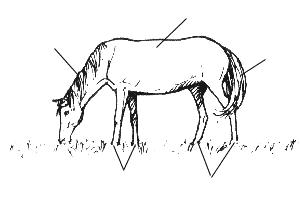Apple trees periodically provide amateur gardeners with such a large-scale harvest that there is nowhere to put the excess fruit. In addition to jam and compotes, there remains one more option for processing fruits - juice. But many people do not get involved with this type of workpiece due to the high labor intensity of the process. Ordinary household juicers simply cannot cope with large volumes of raw materials, and not everyone is ready to buy a professional machine for the season. But there is great option– quickly and efficiently squeeze juice from apples using a home-made press.
What materials will be needed
To make a standard press yourself, you do not need special skills or drawings. Anyone can measure, saw off a strip, hammer a nail or tighten a nut if desired. It is not necessary to own a welding machine; any design can be reproduced in wooden version using ordinary gardening tools .

For the manufacture of home press The tools you will need are a hacksaw for wood and metal (or a grinder), welding machine, screwdrivers, pliers, hammer. As for materials, the following are mainly used:
- metal channel;
- wooden blocks, slats, boards;
- self-tapping screws, bolts and nuts;
- tank or barrel, steel sheet from of stainless steel;
- bench screw and nut, valve, threaded rod or jack - depending on the chosen design;
- durable fabric with good drainage properties for apple bags: calico, cotton, jute burlap, linen.
It is better to make wooden elements from oak, birch or beech, since materials from biologically active tree species (spruce, pine) can change the taste of the juice. Under no circumstances should drainage grates be made from chipboard: fine dust impregnated with phenol-formaldehyde glue will get into the product.
Types of designs: diagrams and drawings
The main thing in the press is solid foundation and working mechanism.
Operating principle of the device:
- layer by layer through drainage grates prepared raw materials for pressing are stacked(chopped apples) in fabric bags;
- by means of a mechanism oppression falls from above and presses the juice.
A good press squeezes out 65-70% of the juice, leaving an almost dry pulp. It’s quite possible to make one with your own hands.
Constructions homemade press differ in the principle of operation of the main mechanism:
- Screw.
- Jack based: mechanical and hydraulic.
- Combined.
In the bulk of structures, the pressure is from above, but in the combined version, compression occurs in two directions: using a screw mechanism at the top and a hydraulic jack at the bottom.
The juice press consists of the following parts:
- sustainable bed;
- quadrangular or cylindrical frame, inside which bags of chopped apples are folded;
- wooden gratings, with which the bags are transferred so that they do not spread;
- piston-gne t, directly exerting pressure on the cake;
- thrust bearing for a jack;
- working mechanism: screw with handle, mechanical or hydraulic jack;
- bowl-tray.
The main body can be:
- single perforated: the juice will flow through the holes along the walls and through the bottom into the pan;

- double: a solid casing with a slightly larger diameter is placed on a perforated metal cylinder;
- in the form of a solid metal body with one drain hole at the bottom;
- collected from wooden slats connected by hoops, − barrel. The walls serve as a drainage grid.

There may be no body at all- simply a pyramid of wooden lattice frames in a tray with a mouth at the bottom, under which a container for juice is placed.

This design easy and quick to install. For the bottom plate, you can take a piece of countertop, for example.
Worm gear or hydraulic jack: what to choose?
The screw (worm) mechanism in the press is implemented in the form of a large screw (threaded axis) with a nut or a mechanical jack. The latter option is much simpler - you can buy it at a spare parts store or take it out of the trunk of a car; you don’t need to look for, adjust, grind or weld anything.
Designs based on a hydraulic jack are much more productive(force from 1t) than mechanical ones, and require a minimum of human labor. Hydraulic bottle jacks make it possible to squeeze juice quickly and in large volumes. They fit comfortably into any design.

You can design a press with a removable mechanism, then you don’t have to buy a special jack, but you can use the one on duty in the trunk. After all, the apple harvest is not good every year.
Making a press yourself
The press needs a stable, strong support - a bed. The simplest thing is to assemble it from wooden blocks using screws. To make a metal frame you will need a welding machine and a channel.
The dimensions of the frame depend on the diameter of the working body or the parameters of the drainage grids. Therefore, if you are planning a hull structure, then you need to prepare the container in advance.
The simplest frame press with a worm mechanism
Welded stable structure. A hole is cut in the center of the upper channel for the screw nut (you can use an old bench or order it from a turner). The nut is welded into the frame.

Then Assembling a wooden drainage grate, which consists of two layers of slats packed perpendicular to each other. The thickness of the slats is not less than 20 mm. It is also necessary to install a stand made of bars. A retainer for the pressure part of the screw is attached to the top board - any metal part of a suitable shape (can be mounted with epoxy glue).

The tray is made of stainless steel sheet, in the front part the spout-drain is arched. All that remains is to substitute a pan or other container. The result is a press.

Bed for hydraulic press assembled according to the same principle as for a screw one. The easiest way to use a body is to take a ready-made metal or wooden barrel. A hole is cut at the very bottom and equipped with a drain spout.
If wooden barrel not completely sealed - even good. The juice will drain in several directions at once, and in the end it will still end up in the pan. It is better to put a plastic casing on top of such a structure larger in diameter to avoid splashing.
You can make a wooden case yourself:
- Will need: several boards of equal size (can be parquet), two strips of stainless steel and self-tapping screws with an anti-corrosion coating.
- The boards are screwed on top and bottom with self-tapping screws to the stripes at a distance of approximately 10 mm.
- Strips with boards are bent in the form of a circle, the ends of the strips are bolted together.
- A plastic bowl of suitable diameter can be used as a tray. with a drain cut out at the bottom for juice.

Another important element is the jack stop.. Usually made of wood: you need to knock down the slats and cut out a circle from the resulting canvas slightly smaller than the diameter of the working body. You can use a grinder to cut out a support from a stainless steel sheet.

Drainage gaskets are made in the same way as in the description for a screw press, but they are given a round shape.
The end result should be a design similar to the one in the photo.

Preparation of raw materials
The principle of squeezing apple juice simple - the finer the raw materials are chopped, the more product will be obtained at the exit. It is best to use a special chopper (crusher), since finely chopping several buckets of apples by hand is theoretically possible, but in fact difficult to implement. An electric meat grinder for large volumes is also not an option: it roars, howls, gets hot, and may eventually burn out. You can also make a suitable crusher yourself.
The simplest design of a homemade crusher
A deep hopper is mounted lightly on the cone from moisture-resistant plywood or stainless steel sheet. For stability, two bars are attached to it from below. A wooden roller (preferably made of beech) with self-tapping screws wound in a spiral is cut into the lower part of the container. You can use a regular kitchen rolling pin as a drum.. The axis of rotation of the roller comes out, a drill is inserted into it and the process begins.
Some people simply crush apples in a bucket using a construction mixer.
The process of squeezing juice from apples at home
After the raw materials are prepared, they laid out in fabric bags or wrapped in pieces of fabric like an envelope. Next, the bundles are placed in a container, basket, or simply on the bottom of the structure in layers through drainage grates. Fits about 3-4 bags. The pressure is lowered from above, the juice flows into the pan. When the squeezing process is completed, the pulp is removed and the next batch is loaded.
The remaining cake after high-quality pressure is usually obtained dry and compressed into “tablets” (photo 16).

It is better to dispose of the pomace in compost heap. Worms reproduce very well on such material, creating valuable fertilizer for the garden.
The resulting juice can not only be drunk fresh, but also prepared for the winter:
- pasteurized rolled juice;
- apple wine several types;
- apple cider.
Apples are a very valuable product for health.. It is extremely imprudent and wasteful to bury and give away surplus crops to neighboring pigs. By building a couple of simple devices, you can quickly and easily process all the fruits. And in winter it will be so nice to take healthy and tasty amber drinks out of the cellar or refrigerator!
The post How to make an apple press with your own hands first appeared About the farm.
The question of whether a juicer can be made with one’s own hands is primarily of interest to owners of summer cottages and garden plots who annually harvest fruits and berries, which need to be quickly processed and preserved. Adding even more relevance to this issue is the fact that juices obtained independently are much tastier and healthier than those sold in stores.
Today, purchasing a juicer of any capacity does not present any particular problems, but such equipment is not cheap. That is why it is advisable to make a juice press with your own hands, especially since the design similar devices not very complex.
How do juice extraction devices work?
Before wondering how to make a juicer with your own hands, you should understand the principle by which it works. To extract juice from fruits or berries, you need to apply pressure to them. According to their design and operating principle, juicers can be of the following types:
- mechanical devices;
- hydraulic;
- electrohydraulic;
- pneumatic.
The simplest in design are mechanical type juicers, which are most often made by home craftsmen with their own hands. The operating principle of such devices, which do not differ high performance, but quite suitable for household use, is based on the fact that the raw material is acted upon by a piston, the pressure on which is exerted using a screw mechanism. Fruits and berries are loaded into a perforated basket, through holes in the walls of which the finished juice flows into a storage tray.

The basket of screw presses can be made of stainless steel sheet or solid wood. Wooden baskets are drainage grates consisting of two halves connected to each other using metal hoops. Screw presses of the design described above can even be used for squeezing apple juice. In this case, the raw materials are loaded into the basket of such a juicer in finely ground form.
How to make a juice press with your own hands
As mentioned above, the simplest in design and, accordingly, the easiest to manufacture are mechanical presses for squeezing juice. To make your own apples, on which you can process other fruit and berry raw materials, you will need the following Consumables and tools:
- stainless steel sheet;
- channel or square metal pipe cross-section 40x40 and wall thickness of at least 3 mm;
- pipe with a diameter of 16 mm;
- a rod with a thread on its surface;
- screw;
- board 30 mm thick;
- welding machine;
- Bulgarian and electric drill;
- hammer;
- hacksaw for metal.
Before you start making a homemade apple juicer, it is advisable to find drawings or drawings of such a device on the Internet or draw them yourself. It would also be useful to watch a video on making a juicer, which shows this process in all its details.
Juicer press options
In the upper part of the resulting press frame, it is necessary to drill a hole into which a nut for the screw mechanism of the device is welded. Depending on whether you need a large or small juice press, select the dimensions of the perforated basket and frame, which performs the function load-bearing element the entire juicer.

A wood board can be used as a piston through which the screw mechanism will exert pressure on the raw materials loaded into the basket (a circle of the appropriate diameter is cut out of it).
Wooden piston Stainless steel piston PTFE piston
Supplies are getting worse and worse. And there’s not much to go into the basement - the July hail pretty much destroyed the entire fruit crop. Therefore, we take a jack in our hands and make a homemade juice press. Further details about the sizes and materials for making a press with your own hands.
On the idea of making a juice press with your own hands
For many years we used a Soviet juicer to obtain juice from apples and pears. But we noticed that after processing the pears into juice, the remaining pulp is quite wet. Using improvised means, a third of the volume of juice was squeezed out of the pulp. That is, if 20 kg of fruit yielded 10 liters of juice, then after squeezing the cake we received an additional 3 liters!
This year's harvest is anything but, and the grandchildren need vitamins, so the question arose of urgently purchasing (the apples are already ripe) a press for squeezing juice. But the search in the city was unsuccessful. That’s why we decided to make our own juice press using a car jack. Fortunately, there is a 1500 kg jack available.
How to make a press from a jack with your own hands: materials, dimensions
The juice press consists of:
- supporting frame,
- juice tray,
- spinning dies,
- cloth for cake;
- jack.
The most labor-intensive process is to manufacture a powerful frame that can withstand tensile pressure of up to 1000 kg. We made the frame from a metal profile and a corner. The width of the frame was determined by the size of the pallet - 36 cm. The height of the frame - by the size of the pallet and jack - 55 cm.
The side posts are made of a rectangular profile 70*25 with a wall of 2 mm. The bottom of the frame is a 50*50 profile. We tried to install the same profile on top of the frame, but during operation the jack began to wrinkle the profile - too thin metal 2 mm. Therefore, the top of the frame was replaced with a 50*5 mm corner. The profiles are connected with two 10 mm bolts in each corner.
Place the pulp in cloth bags. The material must be dense enough so that it does not burst under pressure. We used calico type sheet fabric. Bags of cake are placed between dies with a thickness of at least 20 mm. It is better to make the top plate on which the jack is installed thicker - 30 mm. On the dies, you can make horizontal cuts 3-5mm deep for better juice outflow.
start squeezing the juice from the pulp

The pulp fabric should be thick

DIY press in action (photo 2015)

put the cake in 2 tiers; the juice flows down the cut grooves in the dies
This type of jack press with a do-it-yourself frame makes fruit processing much easier. The press is good for squeezing apples, pears and grapes. All carrion and “substandard” material removed from trees is recycled. And now the completely pressed cake goes into compost, and the vitamins will go to our grandchildren.
As you can see, a homemade press from a jack is easy to make with your own hands. And on the farm he indispensable assistant. Surely, you will also find metal profiles and a baking tray on your site, which will be a useful addition to a regular car jack. Moreover, you can use not only a hydraulic jack, but also a mechanic one.
There are various juice press designs. The main homemade structures are screw or using a jack. A good option when using an air jack or a rubber bladder and a compressor. There are options for using a centrifuge, for example an old washing machine. Presses or juicers should not crush seeds and ridges located in the pulp. Depending on the expected volume of processing of raw materials into juice or wine, select the design of the juice extraction device you like. In any case, the cooking process is divided into two stages: 1. Preparation of pulp (grinding raw materials); 2. The actual extraction itself is the extraction of juice.
Screw Juice Press Designs
Typically a press consists of a pressing mechanism, a basket, a base and a pressing board. The basket serves as a receiver for the pulp and is installed on the base of the press. There is also a tray for draining juice. Bottom and side walls the baskets are lined with a whole piece of burlap without gaps. The ends of the fabric should hang over the edges of the basket. Then the pulp is loaded into the basket and covered with the ends of the burlap. A wooden circle is placed on top, onto which the press head is lowered.

Screw press with metal basket. Device: 1. Screw; 2. Bed; 3. Gutter for juice flow; 4. Basket

Screw press with woodbasket. Device: 1. Screw; 2. Bed; 3. Basket; 4. Juice drainage chute

Frame screw press . Device: 1. Packages with crushed raw materials; 2. Screw; 3. Bed; 4 Drainage grates; 5. Juice drainage chute
Design screw juice press is clear from the pictures. Here is an example of another homemade juice press. The press consists of two pipe stands with a diameter of 22 mm. A U-shaped profile bent from 3 mm steel is welded to the pipes on top. The height of the profile is chosen in such a way that a screw nut pressed into a steel sleeve can be freely placed inside. A clamp is welded to the bottom of each rack. Using these two clamps, the press is attached to the window sill. A head with a hole for the handle is welded to the screw on one side, and a stop is attached to the other, which compresses the raw material.

1 - clamp; 2 - stand pipe; 3 - crossbar; 4 - screw; 5 - emphasis; 6 - table; 7 - bushing with a pressed nut.
A leaky 3-4 liter enamel pan is suitable for collecting the squeezed juice (Fig. a). You need to drill a hole in the bottom and secure a fitting with a hose in it to collect the juice.
The basket (Fig. b) is made of stainless steel sheet 2 mm thick; bandage rings made of stainless wire with a diameter of 4 mm are welded to it on top and bottom. The rings allow the basket to fit “evenly” inside the pan. The walls of the pan are perforated with a drill with a diameter of 3 mm (in random order).


Gaskets (Fig. c), which separate portions of raw materials loaded into the basket, consist of two 2-mm stainless steel disks connected by spot welding. Holes are drilled in the disks using a drill with a diameter of 3 mm, and gaskets 4 mm thick are provided between the disks (the gaskets are also made of stainless steel). In general, all parts of the screw press are made of stainless steel; a tank from an old one is quite suitable washing machine.
For getting good harvest-, as well as growing strawberries at home. The work of squeezing juice occurs as follows. The body of the press is secured with clamps on the windowsill in the kitchen (you can also install the press on the table). The screw with the stop is unscrewed until it stops. A basket is placed in the pan, and a gasket is placed on the bottom of the latter and a napkin made of durable fabric is placed on it. Next, crushed raw materials (apples, fruits, herbs, berries) in an amount of 0.5...1 kg are placed on a napkin. The napkin is folded into an envelope, the portion is covered with a drainage pad, on which another napkin is placed. There should be 3 such bags, and the top bag can rise 4...6 cm above the pan. Putting a gasket on the top bag, the pan is placed under the press screw. Yes, I completely forgot to mention the spacer (a circle of wood) that is placed under the basket (otherwise the pan may become unusable when the screw is tightened). When creating pressure, the screw must be turned slowly and smoothly, monitoring the release of juice. Having finished squeezing the juice, unscrew the screw upward, transfer the pan to the table, and remove the pulp from the napkins. Depending on the type and quality of the raw material, in one cycle, using a homemade screw press for squeezing juice, it is possible to squeeze out 1.2...1.8 liters of juice, and in 1 hour - up to 12...15 liters.
Wedge press for squeezing fruit juice

It is necessary to arrange a wooden trestle on four legs B, 1 m high. At the top, these legs are connected by a thick (9-10 cm) board A, the width of which is 30 cm and the length is about 1 m. We make a longitudinal slot D in the board, 10-12 cm wide and long 40 cm. Into this slot we insert two boards B (thickness 9-10 cm), hewn at the top and bottom. At the bottom, we tie both boards with an iron bracket or, even simpler, with a thick rope. In order for the boards to hold and not fall into the slot, we pass iron pins or wooden bushings in their upper part. Then from hard rocks wood, we make several wedges of different thicknesses - and the press is ready. It works like this: spreading the boards B apart, inserting a bag of strong canvas filled with pulp between them. Then, driving wedges into the slot, we squeeze the boards. This way we compress the pulp tightly. The juice flows down into a placed tub or pot.
Making a simple juicer using the lever principle

We take two birch boards, the length of the main board is 1 m, width - 300 mm, thickness - 100 mm. The second board, which serves as a lever, is 1.5 m long, 170 mm wide and 20 mm thick. In the main board we make grooves for juice drainage (Fig. a) 10-15 mm deep and 300 mm long. We strengthen this board obliquely either on separate racks or on a special table. We attach a second lever board to it using a hinge and a spacer board (Fig.b). Got lever press. We put 4-5 apples or some other fruits in the opening, press the lever, and the juice flows down the grooves into the placed container.
Finally, examples the most simple devices for squeezing juice not requiring description. For home winemakers - a guide to making homemade grape wine


A high-performance DIY juicer is useful for gardeners who have to process large volumes of fruits and berries during harvest. IN living conditions Factory devices are used to meet the need for small portions of freshly squeezed drink.
Device types
Before you make a juicer with your own hands according to your own drawing, you need to study the principle of operation of the device. Depending on the design capabilities, squeezing processes can be carried out in compliance with a certain sequence of work stages or simultaneously.
Centrifugal juicers process the fruits into a pulp. They work according to a scheme in which, after grinding by a centrifuge, pressing occurs using a press. An auger juicer allows you to extract juice from fruits during processing.
Selection necessary elements designs are carried out depending on the type of device for squeezing juice. To simplify the processing process, fruits are crushed, for example, using a manual beet cutter. Complex designs involve the use of a mechanical drive for grinding.
Screw devices by design and appearance are close relatives of the home meat grinder. With their help, you can simultaneously grind and squeeze juice; they require more time to manufacture.
To prepare homemade fruit drinks, household appliances that can handle small volumes are often used. To process a bountiful harvest, the way out of the situation is a homemade juicer for apples and other fruits.
A simple old-fashioned method of extracting juice from fruits involves the stage of grinding and squeezing the liquid from the resulting mass. The apples, peeled from the core and spoiled parts, were poured into a wooden trough. Using a special chopping knife, the fruit was processed into a homogeneous mass.
The prepared pulp was packed in gauze and placed under a press in a wooden tub. To collect apple juice in a container, the design provided a hole in the bottom of the device to drain the liquid. The role of the press could be performed by heavy objects (stones).

The screw version of the press was equipped with:
- the frame on which the device is mounted;
- a screw with a fixed or removable handle;
- a board for support, round in shape, corresponding to the diameter of the inside of the container.
How to create a high-capacity screw press for apples can be seen in the video. A do-it-yourself apple juicer is assembled from prepared parts.
To create the structure, you need to prepare 2 pipes, onto which they are fixed on top by welding metallic profile. A hole is made in the upper part of the profile into which a threaded head is inserted.
At the bottom of the screw, the design provides a stop for squeezing. The rotation handle is fixed at the top, and clamps or clamps are permanently welded at the bottom. supporting structure for fastening. The technical capabilities of the press depend on the volume of the tub into which the crushed raw materials are placed for pressing.
During operation, such a device is labor-intensive due to the execution of a significant part self made.
Hydraulic device
You can reduce labor costs for making juice using a design with a jack. To make it you will need:
- rolled metal (angle, channel);
- perforated basket;
- board;
- screws for fastening;
- short log.

The component parts of the frame are measured and welded into a structure. Holes are drilled in the pan.
Chopped apples are placed in a container. A wooden circle cut from a board is installed on top, equal to the diameter of the perforated basket. A piece of wood is placed on top. The hydraulic juicer is driven by a jack.
Automated design
A washing machine juicer is considered a popular option for extracting juice. The following parts are used to manufacture the device:
- centrifuge;
- ball bearings;
- fastening units.
All component structures must be cleaned of powder and scale residues before use. All holes in the tank are closed with rubber stoppers, leaving only one to drain the juice. It is useful to install a mesh above the drain outlet to filter the juice.
To grind fruits, a standard centrifuge requires additional modifications. The problem can be solved by using a steel lining, in which holes are drilled and teeth are filled.
A stack installed on the walls of the centrifuge can crush raw materials. Preparation work surface The drum involves enlarging the standard holes and installing the notches with the sharp part inward in the direction opposite to the rotation of the drum.
The completed grater is mounted in the tank using ball bearings and fasteners. The design is located in a vertical housing, the lid of which is closed with latches. A hopper for receiving fruit is placed in the upper part of the hole.
When operating the device, the main thing is to ensure stability from vibration. It is recommended to secure the housing on a rigid base, and provide a limiter for the hopper. The engine of the device is borrowed from a washing machine. It can be mounted inside and outside the structure.
A screw device for squeezing juice is a more labor-intensive option. The main part of the parts is made individually. These include:
- frame;
- screw;
- juice tray;
- bunker;
- engine.
The structure is assembled and mounted on a stand made of a metal frame with an installed engine. The rotation of the auger is ensured by a belt drive from the engine to the pulley.
Grape processing
Before the advent of devices for making juice, it was used manual labor. Along with winemaking technology, from ancient times came the tradition of crushing grape fruits with one's feet.
At home, it is used for small harvest volumes. Special presses help process a significant amount of fruit.
There are presses various designs. They can be equipped with an automatic or mechanical drive, set in motion using a screw or jack. The devices work by loading grapes into a container that looks like a barrel.
Under the influence of a force that moves downward, the grapes are crushed. The resulting juice flows out through the holes.
A DIY grape crusher works on the same principle as a washing machine. Therefore, when making homemade designs Parts from old machines are used to process berries.








